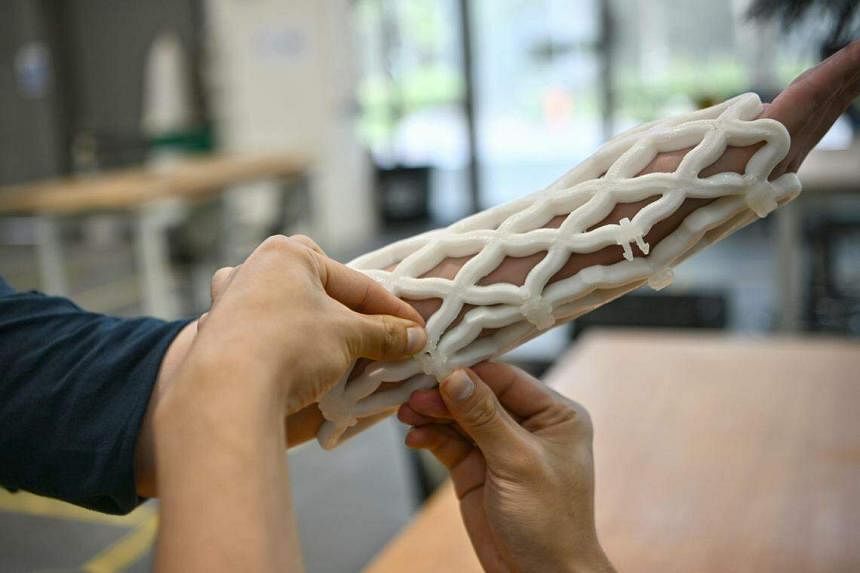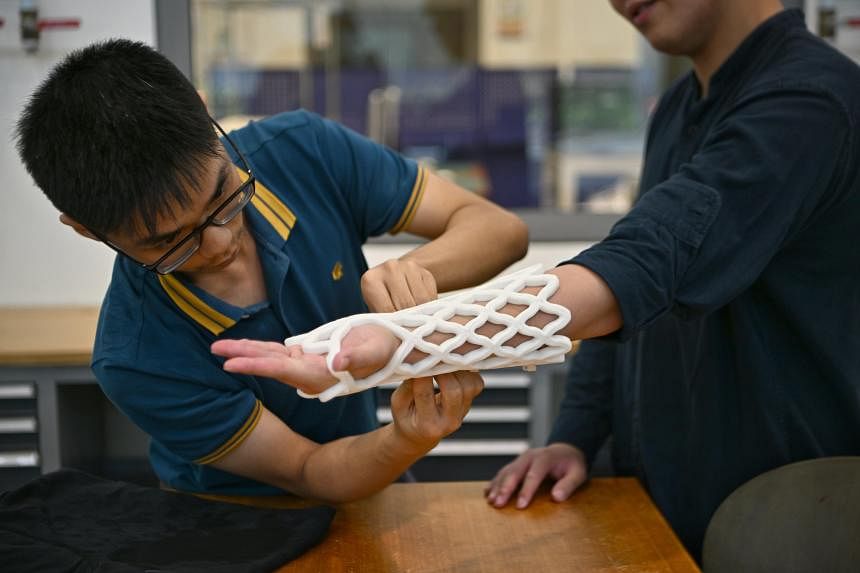SINGAPORE - A new medtech start-up has come up with a cast for fractured bones using 4D-printing that conforms to a patient’s limb and becomes rigid after cooling down to provide the required support.
Founders of Castomize told The Straits Times its patented 4D-printing core technology is a step up from its previous attempts at 3D-printing, as the cast can be reshaped according to how the bone is healing.
It is also worlds away from the traditional plaster cast, they said.
“Unlike standard medical casts that require the use of many disposable bandages, stockinette and the plaster cast itself, which will all be thrown away when the state of the wound changes and another cast has to be applied, our 4D-printed cast can be removed as the patient heals, and easily remoulded.
“This means the patient can wear the same cast until they are fully recovered,” said Mr Abel Teo, 27, one of Castomize’s three founders.
He said this allows doctors to make adjustments throughout the patient’s recovery.
A spin-off of the Singapore University of Technology and Design (SUTD), Castomize was established in 2022 to improve the comfort and convenience of traditional orthopaedic devices.
Two of its three founders are SUTD graduates, while Mr Teo graduated from the Singapore Management University’s (SMU) business school.
“The idea started after a friend broke his arm while mountain climbing and was complaining about how uncomfortable his plaster cast was. He was also trying to relieve itch by using a ruler to reach inside,” Mr Teo said.
Co-founder Eleora Teo, 27, said the team experimented with 3D-printed casts but found that each needed a long lead time of between three days and a week to be created and customised.
Continuing the work after graduation, they were able to develop a polymer that lent itself to 4D-printing because of its ability to respond to heat to be reshaped.
“This is the smart material used to create the fourth dimension for the 4D-printed medical cast,” co-founder Johannes Sunarko, 26, said.
It was also safe for medical use.
“It provides the same rigidity for a tenth of the material needed and requires only three minutes to apply. It’s also waterproof and not itchy, and it allows doctors to monitor the healing process with greater ease,” Mr Teo said.
He said the cast can also be salvaged and reused in first aid kits due to its malleability when heated.
“We want to send them to areas where there is insufficient healthcare infrastructure or that face a lot of natural disasters. This way, we are hoping to save lives and improve the standard of care for victims in disasters,” Mr Teo said.
It was at the Singapore Week of Innovation and Technology (Switch) 2022 that Castomize caught the eye of the National Health Innovation Centre, an agency that provides translational funding and strategic guidance to accelerate healthcare innovation.
Castomize has been awarded several grants and awards from organisations such as the National Research Foundation of Singapore and is working with several incubators and accelerators such as Shinhan Square Bridge Incheon, SMU’s Business Innovations Generator, Temasek Launchpad and SUTD.
Orthopaedic experts in five hospitals in Singapore and South Korea are testing out the casts and providing feedback. Castomize has also inked several sales and research-and-development letters of intent and memorandums of understanding with several organisations in the Asia-Pacific, including in Singapore, according to Mr Teo.
The team is working with hospitals and healthcare organisations in the Asia-Pacific to further test and implement their product.

The team is also working with orthopaedic surgeon Michael Yam from Tan Tock Seng Hospital (TTSH) to explore different and new aspects of design in a study conducted with the hospital.
Dr Yam believes that the collaboration will allow “patient-specific care in a bespoke manner”.
“It can be implemented and scaled up to almost every aspect of orthopaedic surgery where there are fractures of any bone in (the limbs). As we progress, we intend to scale up our collaboration and design solutions to fit the use cases and needs of other types of injuries,” he said.
Dr Yam, who heads the medical 3D-printing centre at TTSH, said the trial is still in the design stage.
Correction note: An earlier version of this article referred to Mr Abel Teo as Mr Tan. This has been corrected. We are sorry for the error.


